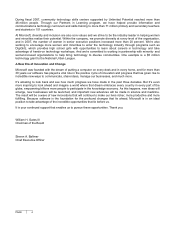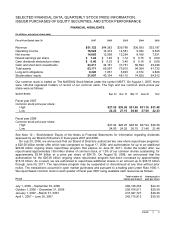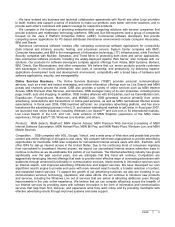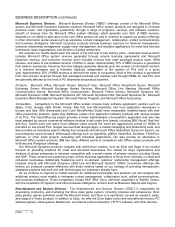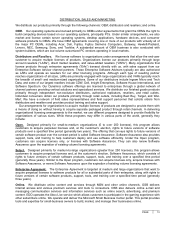Microsoft 2007 Annual Report Download - page 13
Download and view the complete annual report
Please find page 13 of the 2007 Microsoft annual report below. You can navigate through the pages in the report by either clicking on the pages listed below, or by using the keyword search tool below to find specific information within the annual report.
PAGE 12
BUSINESS DESCRIPTION (CONTINUED)
components from these vendors in the future. Beyond the exceptions noted, we generally have the ability to use
other custom manufacturers if the current vendor becomes unavailable. We generally have multiple sources for
raw materials, supplies, and components, and are often able to acquire component parts and materials on a
volume discount basis.
PRODUCT DEVELOPMENT
During fiscal years 2007, 2006, and 2005, research and development expense was $7.12 billion, $6.58 billion,
and $6.10 billion, respectively. These amounts represented 14%, 15%, and 15%, respectively, of revenue in each
of those years. We plan to continue to make significant investments in a broad range of research and product
development efforts.
While most of our software products are developed internally, we also purchase technology, license intellectual
property rights, and oversee third-party development and localization of certain products. We believe we are not
materially dependent upon licenses and other agreements with third parties relating to the development of our
products. Internal development allows us to maintain closer technical control over our products. It also gives us
the freedom to decide which modifications and enhancements are most important and when they should be
implemented. Generally, we also create product documentation internally. We strive to obtain information at the
earliest possible time about changing usage patterns and hardware advances that may affect software design.
Before releasing new software platforms, we provide application vendors with a range of resources and guidelines
for development, training, and testing.
Business and Product Development Strategy. Innovation is a key factor affecting Microsoft’s growth. Our
model for growth is based on broad adoption of innovation, willingness to enter new markets, and embracing and
acting on disruptive trends. We continue our long-term commitment to research and development, including
advanced work aimed at innovations, in a wide spectrum of technologies, tools, and platforms; communication
and collaboration; information access and organization; entertainment; business and e-commerce; and devices.
Increasingly, we are taking a global approach to innovation. While our main research and development facilities
are located in Redmond, Washington, we also operate research facilities in other parts of the United States and
around the world, including China, Canada, Denmark, England, India, Ireland, and Israel. This global approach
will help us remain competitive in local markets and attract top talent wherever it resides.
Based on our broad focus on innovation and long-term approach to new markets, we see the following key
opportunities for growth:
• Consumer technology. To build on our strength in the consumer marketplace with Windows Vista, the
2007 Microsoft Office System, Xbox 360, Microsoft Windows Live, Windows Mobile, and Zune, we are
focused on delivering products that we believe are compelling and cutting edge in terms of design as well as
features and functionality. To succeed in consumer technologies, we also are working to define the next era
of consumer electronics. In the past, consumer electronics was a hardware-centric business; today, the
innovation in consumer electronics devices lies in the software that powers them. This is creating new
opportunities for us to deliver end-to-end experiences.
• Software plus services. Underlying our opportunities in consumer technologies, and in all of our
businesses, is a company-wide commitment to fully embrace software plus services. The ability to combine
the power of desktop and server software with the reach of the Internet represents an opportunity across
every one of our businesses. As we continue to build out our services platform, we will bring a broad range
of new products and service offerings to market that target the needs of large enterprises, small and
medium-sized businesses, and consumers.
• Expanding our presence on the desktop and server. While we enjoyed success in fiscal year 2007 with
the launches of Windows Vista and the 2007 Microsoft Office System, we see potential for growth by
delivering more value per customer. With the planned releases in fiscal year 2008 of Windows Server 2008,
SQL Server 2008, and Visual Studio 2008, and the possibility to provide additional value in security,
messaging, systems management, and collaboration, we believe we are well-positioned to build on our
strength with businesses of all sizes. We will continue to pursue new opportunities in high performance
computing, unified communications, healthcare, and business intelligence. Emerging markets are also an
important opportunity for us. In fiscal year 2007, we announced the expansion of our Unlimited Potential
program as the foundation for our efforts to reach the five billion people around the globe who do not have
access to PCs and digital technology today.




